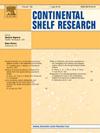波罗的海南部沿岸和过渡水域的水文地貌--基于指数的新评估方法
IF 2.1
3区 地球科学
Q2 OCEANOGRAPHY
引用次数: 0
摘要
该研究旨在开发一套完整的方法,用于对波罗的海南部地区过渡水体和沿海水体的水文形态状况进行分类,并使其适应当前的立法和海洋管理要求。该方法考虑了影响和压力指标,如在沿海和海洋地区开展的基础设施和活动,它们可能会影响水文地貌状况和生境条件的变化。该方法涵盖了水动力条件的变化,如波浪制度、海流、淡水流入,以及由主要沉积物分 布确定的形态变化。该方法基于七项指标。采用行政、测量和再分析数据对其进行分类。指标得分用于计算水文地貌质量指数(HQI)。根据 2022 年的数据,水文地貌状况分类显示,7 个水体的水文地貌状况良好,4 个水体的水文地貌状况中等。本文章由计算机程序翻译,如有差异,请以英文原文为准。
Hydromorphology of the southern Baltic coastal and transitional waters – New index-based assessment method
The research aimed to develop the complete method for the classification of the hydromorphological status of transitional and coastal water bodies in the southern Baltic region with its adaptation to the current legislation and marine management requirements. The method considers impact and pressure indicators, such as infrastructure and activities carried out in coastal and marine areas, which may affect the change of hydromorphological status and habitat conditions. The methodology covers the change in hydrodynamic conditions, such as the wave regime, sea currents, freshwater inflow, and morphological changes defined by the dominant sediment fraction. The methodology is based on the seven indicators. Administrative, measurement and reanalysis data were used for their classification. The indicators scores were used for the hydromorphological quality index (HQI) calculation. Based on data from 2022, the classification of hydromorphological status showed good status in seven and moderate status in four water bodies.
求助全文
通过发布文献求助,成功后即可免费获取论文全文。
去求助
来源期刊

Continental Shelf Research
地学-海洋学
CiteScore
4.30
自引率
4.30%
发文量
136
审稿时长
6.1 months
期刊介绍:
Continental Shelf Research publishes articles dealing with the biological, chemical, geological and physical oceanography of the shallow marine environment, from coastal and estuarine waters out to the shelf break. The continental shelf is a critical environment within the land-ocean continuum, and many processes, functions and problems in the continental shelf are driven by terrestrial inputs transported through the rivers and estuaries to the coastal and continental shelf areas. Manuscripts that deal with these topics must make a clear link to the continental shelf. Examples of research areas include:
Physical sedimentology and geomorphology
Geochemistry of the coastal ocean (inorganic and organic)
Marine environment and anthropogenic effects
Interaction of physical dynamics with natural and manmade shoreline features
Benthic, phytoplankton and zooplankton ecology
Coastal water and sediment quality, and ecosystem health
Benthic-pelagic coupling (physical and biogeochemical)
Interactions between physical dynamics (waves, currents, mixing, etc.) and biogeochemical cycles
Estuarine, coastal and shelf sea modelling and process studies.
 求助内容:
求助内容: 应助结果提醒方式:
应助结果提醒方式:


